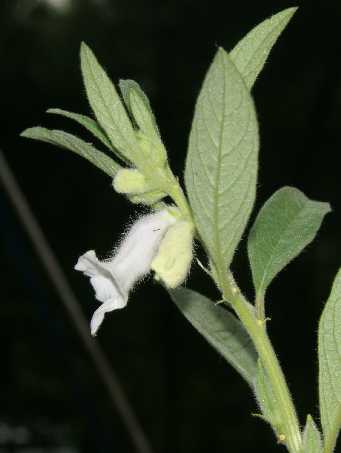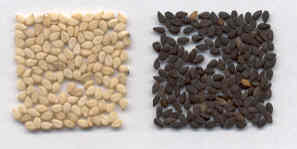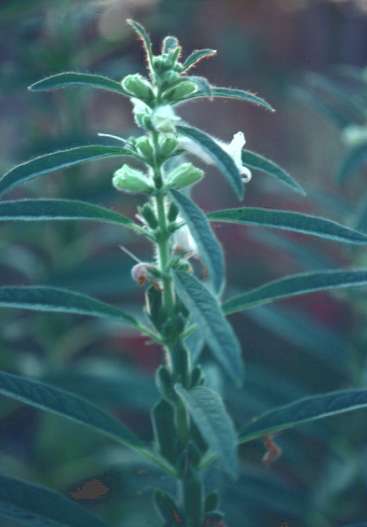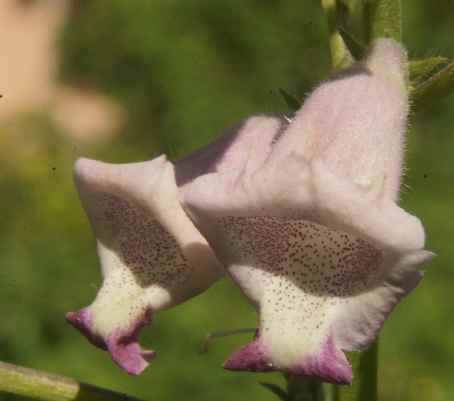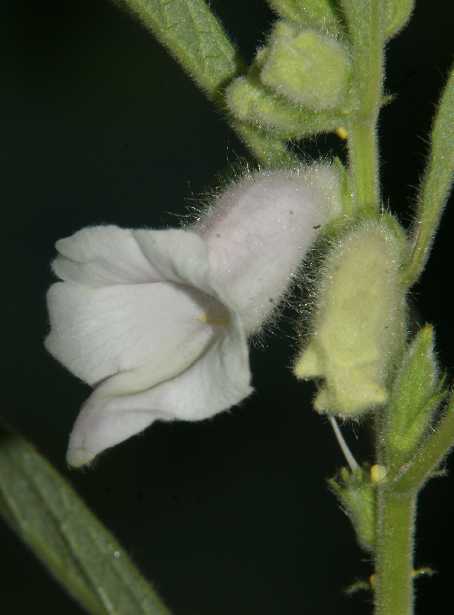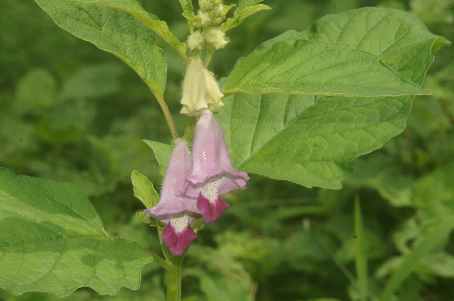
|
| Sesame flowers |

|
| Sesame flower |
Basically, nearly all seeds contain some kind of stored energy used as a fuel by the young plant in the first phase of its life (those few plants which do not store energy in their seeds have highly specialized alternative strategies, e. g., endotrophic mycorrhiza in the orchid famly). Energy is sometimes stored in the form of proteins, e. g. in the bean family (beans, peas, lentils); yet much more common in the use of carbon hydrates (e. g., cereals) or fat to store energy. Oil obtained by pressing such seeds contains besides true fats (lipids) several more constituents: Aroma compounds, which make up for the culinary character of the oil, vitamins, trace elements and more. With respect to lipids, in the plant kingdom nearly pure glycerides, one can further distinguish between saturated and unsaturated fats.
Among the unsaturated fats there are several essential; failure to incorporate enough of them leads to disease. Yet saturated fats are better for cooking, because they can be heated to higher temperatures and have longer shelf life. Also, some aroma compounds decompose at higher temperature, imposing a burnt flavour to the dish.
Cold‑pressed oils (in more recent literature also called native oils) contain a wealth of aroma compounds and their aroma resembles the plant they were obtained from. They must be heated carefully to preserve their aroma compounds; otherwise, the advantage of cold pressure is lost. Cold-pressed oils are perfect for salads and well-suited for dishes prepared at temperatures not much higher than the boiling point of water. A famous example is extra vergine olive oil; some other examples are walnut oil, poppy oil and rapeseed oil.
The term cold-pressed
is somewhat confusing, because even cold-pressed
oils
are not obtained at refrigerator or even room temperature; due to friction in
the seeds the temperature may rise well up to 40 °C. Some oil mills
improve the quality of their products by artificial cooling during the extraction
procedure. Cooling increases the quality of the oil; it is particularly
important for obtaining highest-quality olive oil.
Some vegetable oils are obtained from seeds that have been toasted before
pressing; typically, these products are very flavourful
(Austrian pumpkin seed oil, Nepalese mustard oil, hemp oil,
Oriental sesame oil). Since the seeds have been exposed to elevated
temperatures before pressing, there is no need to keep the temperature low in
the following steps: typically, extraction takes place at 60 to 80 °C
(even higher temperatures would further increase the yield, but lead to
development of off-flavours, see below).

|
| Ripe sesame capsules (S. radiatum) |
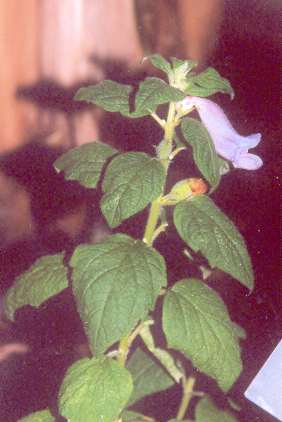
|
| Flowering sesame plant (S. radiatum) |
Hot-pressed oils are much cheaper, since pressing yield increases with the temperature; even the waste from a first pressing may be reprocessed to give more oil at high temperature (above 100 °C). Solvent extraction, finally, gives nearly quantitative yield. Yet in the heat, a large number of unpleasant smelling or even toxic compounds may form and make most hot-pressed oils unsuited for human consumption. Thus, a further step called refinement is needed to remove free fatty acids, solvent residues and all aroma compounds, leaving a bland oil consisting purely of lipids.
Refined oils are common in the West, on one hand because strong flavours are not popular anyway and on the other hand because they are stable up to high temperatures and are thus perfectly suited for deep frying. For the taste, it’s not of much importance which plant they are obtained from, but their thermal stability and content of multiply unsaturated fatty acids depends on the plant species. The most popular refined oils in Europe are sunflower, corn, sesame and safflower oil and the solid coconut fat.
Margarine is made by hydrogenation of vegetable oils, whereby unsaturated
fats are converted into saturated fats. Because of loss of the valuable
polyunsaturated fatty acids, it is less valuable but, on the other hand, it is
a cholesterol-free plant product and thus still bears some dietetic advantages
compared to butter. Culinarily, of course, butter is far superior, even if
butter-flavoured
margarines are sold.
Sesame oil is traded in any of the forms described above: Refined sesame oil is very common in Europe and the USA; most margarine is made therefrom. Cold-pressed sesame oil is available in Western health shops. In most Asian countries, different kinds of hot-pressed sesame oil are preferred.
For example, a hot-pressed sesame oil is the preferred cooking
medium in Southwest India (mainly, the union state Maharashtra) and Burma (see
also onion for Burmese curries). A specialty
particular worth noting is oriental (dark) sesame oil, which is obtained by
toasting the seeds before pressing. Dark sesame oil (Chinese
xiang you [香油] fragrant oil
,
Korean cham girum [참기름])
is a common flavouring in Korea and in the Chinese province Sichuan (see also
Sichuan pepper), where it is used drop by drop as a
condiment, e. g., for Sichuan hot and sour soup (suanla tang [酸辣湯]);
in parts of China, it is commonly flavoured with crushed dried
chiles.
Dark sesame oil is not suitable as a frying medium, unless it is diluted
with bland oil; for example, Japanese tempura [テンプラ] is made by
deep-frying battered vegetables in a mixture of one part sesame oil and ten
parts vegetable oil (see perilla).
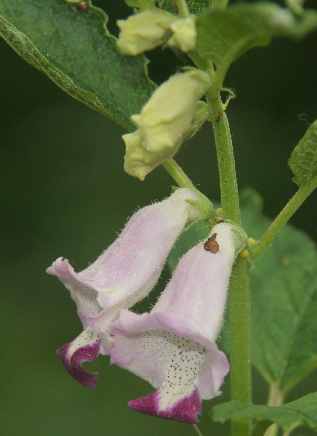
|
| Sesame flowers |

|
| Sesame flower (front view) |
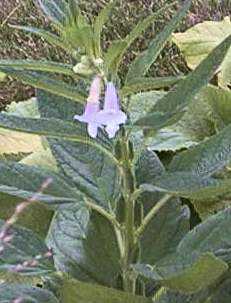
|
| Sesame plant in flower |
Toasted sesame seeds are a common spice in Eastern Asia; it is often sprinkled over Japanese and Korean dishes. It forms part of shichimi togarashi, an exotic spice blend of Japan (see Sichuan pepper). A simpler mixture from toasted sesame seeds with about 10% salt is known as gomashio (wrongly gomasio) [ごま塩, ごましお] in Japan; it is usually sprikled over dry rice dishes.
Chinese sesame paste (zhi ma jiang [芝麻酱])
is made from toasted sesame seeds and has a very strong flavour
resembling Chinese sesame oil; it is used mainly for salad
dressings and sauces for cold appetizers like Sichuanese
guai wei ji si [怪味雞絲, 怪味鸡丝] strange-flavoured chicken threads
,
which is a salad made from precooked chicken meat cut in fine slivers with a
dressing of soy sauce, sugar, black vinegar (hei cu [黑醋]), sesame paste, sesame seeds,
chile oil and toasted
Sichuan pepper. The unusual (hence strange
)
combination of flavours make this dish as unique as delicious. In China, it
is also known as bang-bang chicken [棒棒雞絲],
named after wooden bludgeons which steet vendors used to force their knives
through the bones and to loosen the meat fibers.
Dried but untoasted sesame seeds are popular in the Near East and occur in the Jordanian spice mixture zahtar (see sumac) and in the Egyptian dukka [دقه] (see thyme). All over Western Asia, tahini [طحينية], a paste made from ground dried sesame seeds, is widely used to thicken and flavour sauces and gravies. Hummus [حمص], a bread spread popular in Israel, Syria and Lebanon, is made from cooked chickpeas, tahini, olive oil, a hint of lemon juice and fresh parsley.
Sesame seeds are quite common in Mexican cookery and appear in one of the country’s most famous creations: mole rojo or mole poblano, a sophisticated sauce that is usually served to baked turkey. See also paprika about mole in general and Mexican pepper-leaf about green mole, mole verde.
What makes mole Poblano so special is the large number of
ingredients that lead to an unsurpassed rich flavour: chicken stock, broiled
tomatoes and tomatillos, raisins, three different kinds of paprika (the holy trinity
of ancho, mulato and pasilla), a handful of tropical spices (cloves, allspice, cinnamon, nutmeg and black pepper), sesame seeds and almonds are combined with a most unusual ingredient,
unsweetened chocolate or, even better, toasted cocoa beans. After a long
simmering period, the sauce is refried in lard which makes its flavour even
more deep and unforgettable.
Some Korean cookbooks refer to a flavouring called wild sesame
(tul-kae [들깨]).
This name, however, does not refer to any sesame variety, but means
perilla, a different plant with fragrant leaves.
